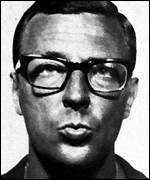Carmine Pecorelli

Carmine Pecorelli (September 14, 1928 – March 20, 1979), known as Mino, was an Italian journalist, shot dead in Rome a year after former prime minister Aldo Moro's 1978 kidnapping and subsequent killing. He was described as a "maverick journalist with excellent secret service contacts."[1] According to Pecorelli, Aldo Moro's kidnapping had been organized by a "lucid superpower" and was inspired by the "logic of Yalta". Pecorelli's name was on Licio Gelli's list of Propaganda Due masonic members, discovered in 1980 by the Italian police.[2] In 2002, former prime minister Giulio Andreotti was sentenced, along with Mafia boss Gaetano Badalamenti, to 24 years' imprisonment for Pecorelli's murder. The sentence was thrown out by the Italian Supreme Court in 2003.
Life
Pecorelli was born in Sessano del Molise, a small municipality in the province of Isernia. During the German occupation of Italy in World War II he briefly enrolled in Junio Valerio Borghese's private fascist militia Decima Flottiglia MAS, forging contacts which would later come in handy during his career as journalist and blackmailer. After graduating in law, he began practicing as a bankruptcy lawyer. Later he became Minister Fiorentino Sullo's head of press service, thereby starting his career as a journalist. He founded a press agency, called Osservatore Politico (OP), which quickly became a newsletter, specializing in political scandals and publishing many first-hand stories that Pecorelli was able to obtain through his numerous contacts in the government, including in secret services. Pecorelli publicly acknowledged that his best pieces were the ones which had NOT been published on OP, due to agreements with the parts involved, which preferred to pay him hefty sums of money to ensure his silence. Pecorelli was able to describe with ease complex situations, often protecting facts and characters behind pseudonyms. For example, he referred to General Carlo Alberto Dalla Chiesa as "general Amen," explaining that it was he who, during the weeks of Aldo Moro's detention in the hands of his kidnappers, had informed Interior Minister Francesco Cossiga of the location of the hideout where Moro was being detained. In 1978, Pecorelli wrote that Dalla Chiesa was in danger and would be assassinated. Dalla Chiesa was murdered four years later, in September 1982.
After Aldo Moro's 1978 assassination, Mino Pecorelli published some confidential documents, mainly Moro's letters to his family. In a cryptic article published in May 1978, Pecorelli drew a connection between Operation Gladio, NATO's stay-behind anti-communist organization (whose existence was publicly acknowledged by Prime Minister Giulio Andreotti in October 1990) and Moro's death. During his interrogations by terrorists, Aldo Moro had made reference to "NATO's anti-guerrilla activities".[1]
Death

Mino Pecorelli was killed in Rome's Prati district with four gunshots, on March 20, 1979. The bullets used to kill him were Gevelot brand, a peculiarly rare type of bullets not easily found on gun markets, legal and clandestine alike. The same kind of bullets were later found in the Banda della Magliana 's weapon stock, concealed in the Health Ministry's basement.
Investigations targeted Massimo Carminati, member of the far-right organization Nuclei Armati Rivoluzionari (NAR) and of the Banda della Magliana; the head of Propaganda Due, Licio Gelli; Antonio Viezzer; and Cristiano and Valerio Fioravanti.
On April 6, 1993, Mafia turncoat Tommaso Buscetta told Palermo prosecutors that he had learnt from his boss Gaetano Badalamenti that Pecorelli's murder had been carried out in the interest of prime minister Giulio Andreotti. The Salvo cousins, two powerful Sicilian politicians with deep ties to local Mafia families, were also involved in the murder. Buscetta testified that Gaetano Badalamenti told him that the murder had been commissioned by the Salvo cousins, as a favor to Andreotti. Andreotti allegedly was afraid that Pecorelli was about to publish information that could have destroyed his political career. Among the information was the complete memorial of Aldo Moro, which would be published only in 1990 and which Pecorelli had shown to general Carlo Alberto Dalla Chiesa before his death.[3] Dalla Chiesa was also assassinated by Mafia in September 1982.
In 1999, a Perugia court acquitted Andreotti, his right-hand man Claudio Vitalone (a former Foreign Trade Minister), Badalamenti and Giuseppe Calò, as well as the alleged killers Massimo Carminati, one of the founder of the NAR, and Michelangelo La Barbera from the charges brought against them.
On November 17, 2002, on appeal, Andreotti and Badalamenti were sentenced to 24 years of reclusion for Pecorelli's murder. The sentence, however, was thrown out by the Supreme Court of Cassation on October 30, 2003.
References
- 1 2 Moro's ghost haunts political life, by Philip Willan, The Guardian, May 9, 2003
- ↑ List of P2 affiliated
- ↑ Maria Antonietta, Calabrò. "Intreccio Pecorelli-Moro: già da un anno s'indaga" (in Italian). Corriere della Sera. Retrieved 19 October 2010.